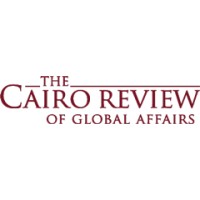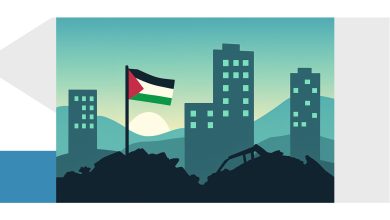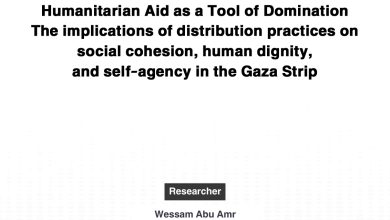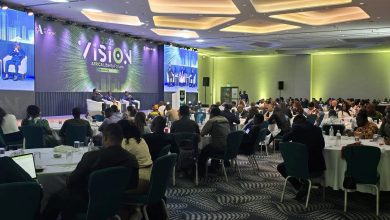A Reading on the Future of Hamas


The aftermath of October 7, and assassination of senior commanders, has forced an existential rethink within Hamas
By Omar Shaban
With the threat of assassination by Israel plaguing each of Hamas’s successional figureheads, the killing of Yahya Sinwar on October 17 will lead to yet another forced restructuring of the group. Sinwar, 61, took over the organization after Ismail Haniyeh’s assassination and, in contrast to his predecessor’s more cautious approach, was known for his overzealous methodology. He had anticipated years earlier that Israeli forces would kill him; he lasted only two-and-a-half months as Hamas’ leader before he was indeed killed.
This most recent killing of another influential leader has forced a shift in Hamas’ operations. Militants who had previously exited the tunnels to fight Israeli forces head-on in the city are returning underground, biding their time. Meanwhile, outside of Gaza, a five-person council consisting of top officials and advisors has been appointed to replace Sinwar. Reportedly created after Haniyeh’s assassination, it may be that Hamas was anticipating Sinwar’s demise and preparing to change tactics. A day after Sinwar’s death was confirmed, Hamas’s deputy director Khalil al-Hayya declared that the group would only become stronger.
In the meantime, Israel is continuing its three-pronged military campaign in Gaza to end Hamas, destroy its military capabilities, and recover the hostages. These aims have not changed since they were announced by an Israeli war cabinet following Hamas’ deadly October 7, 2023 attack. Since then, policymakers in the region and beyond have begun to develop “day after” scenarios for the Gaza Strip on the assumption Israel will meet its stated objectives.
These scenarios, however, have so far proven to be premature, focused on only one aspect of the conflict—who is qualified to take over governance in the Gaza Strip after Hamas is supposedly destroyed. They have neglected to address with equal vigor Hamas’ fate as a resistance movement, a social service system, and a government that has ruled the Gaza Strip since June 2007. A parallel question is the fate of its military capacities that will undoubtedly remain after the war’s end.
To date, the Israeli campaign against Gaza has significantly weakened Hamas’ fighting capabilities at the cost of a catastrophic civilian death toll and the most extensive wholesale destruction of infrastructure on a scale unprecedented in modern history. Hamas has lost control of some areas of the Gaza Strip, especially in Gaza City and the northern regions, and its leaders have admitted that the war had destroyed 20 percent of the movement’s capabilities. According to a June report from the U.S.-based Council on Foreign Relations, however, Hamas’ fighting capabilities in personnel have been cut by half.
Nevertheless, 13 months after the start of the war, Hamas appears to be continuing to function, inflicting losses on the Israeli military in Gaza and maintaining a degree of governance in certain areas of the Strip.
In late June, Israeli military spokesperson Rear Admiral Daniel Hagari told local media that the central objective to wipe out Hamas may not entirely be met: “The idea that it is possible to destroy Hamas, to make Hamas vanish—that is throwing sand in the eyes of the public.”
Politically, Hamas still maintains negotiating clout, both directly with Arab and regional partners—Egypt, Qatar, Turkey, China, etc—and indirectly with the United States and Israel, to reach a ceasefire and release the hostages. Furthermore, the senior Hamas leadership outside Palestine is still able to communicate with its cadres inside the Gaza Strip.
Despite analysis and speculation that Hamas—with all its components as a movement and a government—will succumb to Israeli military might, predictions of its departure as a critical Palestinian entity have not materialized. A careful study of Hamas’ evolution in structure, orientation, and pursuits since its inception is necessary to chart the possible futures available to the movement once the guns fall silent.
Between Resistance and Governance
Hamas was founded at the end of the 1980s as an Islamic resistance movement embodying the Palestinian people’s struggle to end the Israeli occupation and achieve freedom and independence. Within a few years of its creation, it became a powerful rival to many factions of the Palestine Liberation Organization (PLO), especially Fatah. Fatah had been leading the PLO since 1965 and the Palestinian Authority (PA) since its return to the West Bank as part of the provisions of the Oslo Accords in the 1990s. However, over time it became clear that the Oslo Accords had failed to realize Palestinian ambitions for statehood or curb Israeli settler expansion into the Occupied Territories. As Fatah’s popularity slowly declined, Hamas’ support grew. In contrast to Fatah, Hamas staunchly rejected any negotiations with Israel, criticized the PLO for bowing to Western demands through the Oslo Accords, and provided extensive social and economic services.
In 2005, Israeli unilaterally withdrew from the Gaza Strip, emptying 21 illegal Jewish settlements and leaving the area under the PA’s control. The disengagement, as the Israeli government called it at the time, was designed to boost Israel’s security; it would also pave the way for the January 2006 legislative elections, the first exercise in Palestinian democratic institution-building.
The Palestinian legislative elections provided the Hamas’ political bureau with the opportunity to abandon much of its clandestine operations and move to more publicly engage in comprehensive Palestinian life, particularly in the Legislative Council. This decision was also due in part to Hamas’ popularity among the masses at home and abroad, rooted in its committed resistance to the Israeli occupation. It also presented itself as an alternative to the PA’s increasingly unpopular administrative program by advocating for reform.
Not surprisingly, and largely due to its social services and economic assistance to Gaza’s beleaguered civilian population, Hamas won a majority of seats during the 2006 elections. Almost overnight, the resistance movement was now expected to engage in politics and governance of a civilian population.
Hamas’ political victory surprised both Israel and the PA. Israel declared Gaza a hostile territory run by an organization it and its Western allies classified as terrorist. The Israeli military, which had unilaterally withdrawn from Gaza in 2005, besieged the territory and arrested hundreds of Palestinians, some of whom were candidates who had won at the ballot box. American and European donors, who had hoped to fund a peace process and democratic transition after the Israeli withdrawal from Gaza, failed to pressure Hamas from disavowing its goal of destroying Israel. A few months later, Hamas fighters kidnapped Israeli soldiers and fired rockets at Jewish settlements as Israel retaliated with the first of many deadly operations in Gaza.
Meanwhile, the PA refused to relinquish power, and the two Palestinian factions were soon engaged in fatal skirmishes. “The schism between Abbas and Fatah in the West Bank and Hamas in Gaza exploded in a bloody set of battles that saw Hamas violently wrest full control of the Gaza Strip in 2007,” the Washington Post wrote at the time.
By 2007, hundreds of casualties were reported on both sides of the inter-Palestinian battles; Israel imposed a complete blockade of the Gaza Strip, severely restricting control over the borders and blocking the entry of essential goods into the territory.
According to the World Bank, the impact of the conflict with the PA, the consequent economic embargo, and repeated Israeli military campaigns left Gaza with the worst-performing economy in the world. Nearly two million civilians suffering from a punitive economic stranglehold struggled to find work, food, medicines, and materials to rebuild after each Israeli onslaught.
Nevertheless, Hamas maintained its hold of Gaza and enjoyed increased popularity. Its involvement in public rule increased when it formed its first government in June 2006 after repeated attempts from neighboring Arab countries, particularly Egypt and Saudi Arabia, to persuade the two factions to form a reconciliation government failed. These initiatives would continue well into 2024, with the latest efforts undertaken by Chinese diplomats.
Since its 2006 election win, Hamas has amalgamated what it sees as its dual roles: as a political movement with a military wing that resists Israeli occupation, as well as its public service role as a government with administrative responsibilities. The duality of its operations in Gaza has significantly affected the nature, priorities, interests, and direction the organization has taken in the years following.
Foremost amongst these shifts is Hamas’ transformation into a public agency responsible for the welfare and security of Gazans. Following the election win, Hamas faced a new set of priorities, such as upholding laws, developing legislation, managing a judiciary, addressing women’s rights and human rights, and working with the international community—elements of governance entirely alien to the nascent underground movement. Here, a new dynamic began to form within Hamas: an authority that employed tens of thousands of employees with multiple government bureaucracies, all dedicated to handling the public, finance management, promoting good governance, and allowing transparency.
The second shift is that since 2006, Hamas has engaged with regional and international political players, transitioning from its former status as a minor player to an influential power broker in domestic Palestinian politics. However, Hamas also became vulnerable to pressures from other countries by entering the global stage and establishing relations with sovereign states such as Turkey, Qatar, Egypt, Malaysia, and others.
For instance, Israel approved a multi-million dollar grant from Qatar to Hamas in 2018 to help the organization pay public salaries and medical services. Since then, Qatar has given Hamas a total of $1.8 billion and has been an indirect influence on negotiations between Hamas and Israel. No longer is Hamas engaging with Israel as an isolated unit; now, it must balance the opinions and goals of its neighbors who support it.
These changes repositioned Hamas as an organization with international dimensions and not merely a local Palestinian resistance movement considered an offshoot of the global Muslim Brotherhood. In addition to its partial transition into a political government in Gaza, Hamas has also manifested itself into a dynamo of stability (and, some may argue, instability) in the region, with supporters and allies worldwide.
Therefore, decisions to determine the movement’s future must consider international dimensions and alliances. In short, the future of Hamas is no longer in the hands of the movement alone—it is now a political body that influences and is influenced by other international players.
Qatar and Turkey, for example, are considered the most closely aligned with the ideology of the Muslim Brotherhood and maintain strong ties with Hamas. Iran, Syria, and Hezbollah have also cultivated a closer ideological and military relationship with Hamas in the last ten years, forming a sphere of influence known as the “Axis of Resistance” to counter U.S. geopolitical machinations in the region.
Hamas’ future is also linked to Israel, which—as an occupying power—controls the Gaza Strip’s crossings and has waged several deadly military forays with U.S. support against the Palestinian people.
The positions of these key players, including their interests, the shifts that have occurred in their policies due to the Israeli war on Gaza, and their interactions with each other will help provide a forward-looking vision for Hamas’ future.
Wearing Down Hamas
Its poor performance in governance and inability to provide essential services, particularly under the suffocating blockade imposed by the Israeli occupation of the Gaza Strip since June 2007, persistent Israeli military campaigns, and its (often deadly) political rivalry with the PA (and regional Arab powers), have cost Hamas some of the popularity it had established in the late 1990s.
Subsequently, following the surprise Hamas military operation on October 7 (known as Al-Aqsa Flood) and the retaliatory and punitive 13-month Israeli war on Gaza, most of the civilian population view the movement through two prisms.
The first is through the prism of resistance to Israeli occupation and the pursuit of national independence and liberation of Palestinian lands. In this, Hamas is viewed favorably both within Palestine and abroad.
The second prism is more critical and relates to homegrown opposition to the group. With the outbreak of the war, the intensification of the pace of killing and displacement (at least 42,000 have been killed, more than any 100,000 injured, and 80% of residential buildings and infrastructure in the Gaza Strip have been destroyed), and the inability of the Hamas government to provide minimum services to the population under the war (as more than one-and-a-half million residents of the Gaza Strip are displaced in tents), criticisms of Hamas policies are increasingly heard on the streets of Gaza.
In the 13 months since the war began, the beleaguered residents of the Gaza Strip have begun to question Hamas’ decision to launch Operation Al-Aqsa Flood. The Palestinian street in Gaza has been hardened by pragmatic thinking influenced by the scale of the humanitarian catastrophe in the Strip and the daily scrimmage for survival. It is worth noting that the increase in grumbling and anger in Gaza is in stark contrast with Palestinian perceptions of Hamas outside of the Strip, where the movement for armed resistance remains remarkably popular.
Nevertheless, for the civilian population in Gaza, the first and foremost issue is immediately ending the genocidal war against them by the Israeli military. When it comes to post-war governance and administration of the Strip, Palestinians in Gaza will support whichever entity actively contributes to stopping the war and working toward reconstruction and rehabilitation in all respects—societal, economic, psychological, and political. Given the above, Hamas’ ability to provide for the needs of the Palestinians is in question.
But does this mean removing Hamas entirely from the political map in Palestine and the region? The most pragmatic answer is, no. Hamas is a resistance movement with an Islamic ideology that is deeply woven into the Palestinian popular fabric and has become an ideological mainstay in the Palestinian lexicon.
Intellectual Crossroads Within Hamas
The Israeli war on the Gaza Strip has caused an intellectual—if not existential—debate within Hamas, primarily questioning whether governance should be abandoned in favor of the advocacy and social works that had empowered and popularized the movement in the 1990s.
The ideological faction within Hamas calling for this return to its roots is weak and lacks influence. Still, it is the most realistic in its read of the Israeli and American positions on the future of Hamas. Israel and the United States agree on a common goal of destroying Hamas politically and militarily, leaving an ideological manifestation as the most likely to survive.
On the other hand, another faction realizes the severity of the diametric challenges facing the group as a resistance movement and a governing authority. They are attempting to negotiate with the international community and the Americans by making substantial concessions on the level of resistance in exchange for being allowed to exercise power within a Palestinian political coalition.
Khalil al-Hayya, the recently appointed deputy head of the Hamas Political Bureau in Gaza, drove this point home when he said that the movement is prepared to agree to a five-year (or more) truce with Israel, and will lay down its weapons to turn into a political party if a Palestinian state is established.
However, other factors, such as the regional interests of the leading Arab powerbrokers, will also significantly impact what type of entity Hamas becomes.
The group’s main ally Qatar has no interest in excluding it as a central force in the Palestinian political scene, as this means losing its regional and international influence—Hamas has long been its ace in the hole in the region. Some, such as the Wall Street Journal, claimed in April that Hamas’ senior leadership is considering moving its headquarters from Qatar to another undisclosed country. This has not happened.
In light of the failure to reach a ceasefire agreement in the Gaza Strip, some media reports claimed that the United States was pressing Qatar to eject Hamas. In June, Hamas denied that it had planned to relocate to Iraq. Nevertheless, there are rumors that before Haniyeh’s assassination in Tehran, Hamas representatives were considering moving to Turkey.
Turkish diplomats have been marketing Hamas to the international community and the Americans as a group ready to make substantial concessions regarding its ideology, policy, and goals and to turn away from armed resistance toward political participation. It is not surprising, then, that Turkish Foreign Minister Hakan Fidan was the first to state that Hamas leaders had expressed their willingness to dissolve the movement’s military wing if a Palestinian state is established on the 1967 borders, indicating that the movement’s leadership had agreed to turn the movement into a political party.
Turkey wants the international community to visualize a Hamas that can be recycled into an entity that can be trusted to govern Gaza. However, although both Turkey and Qatar wield considerable influence over Hamas, there are limitations to how much they can do.
There may be an understanding in Washington that the American containment of Hamas, in which Qatar has played a central role, may no longer be working. Doha, although a chief mediator in all talks for hostage and ceasefire deals, has earned the ire of the Israeli government and citizenry for funding Hamas in the first place. This move was given both American and Israeli blessings as part of the containment paradigm, empowering Hamas to focus more on governance rather than resistance with Qatari money paying public salaries.
The Americans may have also become convinced that Qatar is hosting a cadre of the Hamas leadership that is not as influential inside Gaza as previously assumed. The final say in any truce agreement and prisoner exchange comes from the Hamas military leadership inside the Gaza Strip, the most important of whom was Sinwar, followed by the leadership of the Izz ad-Din al-Qassam Brigades. His removal from the political question now poses uncertainty about the future of Hamas and the Strip.
Nevertheless, it shouldn’t be overlooked that the decision to carry out Operation Al-Aqsa Flood likely came from within Gaza alone; Qatar likely could not have prevented it or provided preliminary warnings for the simple reason that the Hamas leadership abroad was not aware of it. It was most probably a decision taken unilaterally by Sinwar and the Brigades. It is also likely that Sinwar distanced Hamas leaders who were incompatible with his vision outside the Gaza Strip after his win in the movement’s elections in 2020.
The formerly Sinwar-fronted military wing became central to the Iranian-led “Axis of Resistance”. As such, Iran’s influence on Sinwar and the Brigades, what happens in Gaza, and the fate of the hostages cannot be ignored. The Brigades are still fighting Israeli forces in Gaza and essentially control the fate of the remaining Israeli hostages. In the meantime, the Hamas leadership abroad had not been able to reach any political agreement in talks with the United States and Israel without Sinwar’s approval. Until recently, Sinwar and the Brigades had remained defiant in their conviction that their military and ideological power could defeat Israel. It remains to be seen how Sinwar’s death will influence the Brigades in the mid-to-long term.
Vision and Zeal: Hamas’ Future
The Gaza-based leadership relied on key points for its continued strength, foremost of which is its perceived legitimacy as a resistance movement against Israeli occupation and its steadfastness inside Gaza.
Second, the Sinwar-led Hamas had relied on Israel’s inability to free the remaining hostages through military operations. Hamas is taking advantage of Israel’s desire to prolong the war; for Israel, as long as the war continues, it will be impossible for Hamas to rebrand in a more palatable fashion to the international community.
The Hamas leadership outside Gaza hopes that future elections for the Hamas politburo (originally slated for 2024, but now to be announced) will lead to fundamental shifts in the group’s governance. Most prominent among these desired shifts is the return of former Hamas power broker Khaled Meshaal to the leadership of the politburo. Sinwar, who held this position since 2016 (two consecutive terms), is now dead and no longer an obstacle to Meshaal’s resurgence.
In the interim, and with the ongoing Israeli war on the Gaza Strip, Hamas currently has three options. The first is laying down arms and altogether abandoning the armed resistance option in exchange for continuing to rule the Gaza Strip with international guarantees—Hamas is leveraging its allies Turkey and Qatar to market this option. This position contradicts the desires of Iran, Syria, and Hezbollah, who want Hamas to remain a resistance movement.
Hamas’ second option is to reconcile with the PA and Fatah and form a national consensus government, where it will play a reduced role in Gaza governance. This avenue is a byproduct of Hamas realizing that it is unable and unwilling to return to power in light of the international community’s—Israel included—opposition to the status quo.
Hamas also realizes that the Israeli war has dramatically weakened its capacities and that its popular support in the Gaza Strip has sufficiently declined to allow it to rule effectively. Nevertheless, Hamas still asserts that it maintains a degree of power that prevents any force or government from operating in the Gaza Strip without Hamas’ consent and coordination. Governing Gaza requires enormous resources and international acceptance, which Hamas does not currently have, but Hamas does have the ability to sabotage its potential replacement. In this scenario, if Hamas approves of the new governing power, it would step back from ruling Gaza and offer its support to the new organization.
Hamas’ third option is to leave Gaza apolitical: a technocratic entity would be established to administer the Strip, composed of statesmen and experts in relief, post-war development and rehabilitation, and humanitarian assistance. This body would not include Hamas or its supporters; however, Hamas would support it from the sidelines and be permitted to communicate with the Israelis and the international community for reconstruction. Meanwhile, Hamas would work to rehabilitate its damaged structure. This proposal is consistent with that of Israeli Prime Minister Benjamin Netanyahu, who rejects the return of the PA to the Gaza Strip and the idea of Palestinian reconciliation, and has vowed to prevent the establishment of a Palestinian state. However, PA Mahmoud Abbas rejected this proposal under the pretext that it isolated the Gaza Strip from his control and prevented the PA from facilitating the reconstruction process.
It is still uncertain how the war will end and what the day after will look like in the Gaza Strip. In the meantime, Hamas is facing an existential crisis that some believe will take three to five years to resolve. During this period, Hamas will likely not return to rule and instead make significant concessions to any entity wishing to govern the Gaza Strip, provided it is given a consulting role. The military wing that has previously enjoyed a considerable budget will likely become defunct. Those funds will be reallocated to social, health, and educational programs and efforts to rebuild the organization. Hamas will spend this time repairing itself, counting its losses in equipment and people, and rebuilding its popular support locally and internationally.




